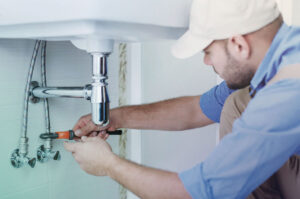Panic hits. The running water across the kitchen floor. You are desperately looking for your phone—who ya gonna call? The emergency plumber call. But there’s plenty you can do to prevent the situation from spiraling into a home-wrecking disaster between now and their arrival. Acting quickly and wisely might make all the difference between a little cleanup and expensive repairs.

First—and this counts—find the main water shut-off valve for your house. Usually found in the basement, crawl area, or even outside for certain houses, it is hidden where the water line enters the house. Give that valve a firm, assured twist. For leaks, burst pipes, or a broken fixture—where water right at the source is really vital—turning it off halt If you hear flowing water but cannot locate the source, listen for hissing or dripping; even the smallest hints can guide you in the correct path.
Got water shooting from a burst pipe? Get buckets or towels and hold the flood. Also helpful is turning off local valves (next to toilets or beneath sinks). Move valuables—electronics, books, that costly rug—away from the direction of damage. Underfoot damp carpet and water-stained family pictures really do hurts like nothing else.
For obstructions, avoid aiming straight for chemical drain cleaners. Those can gradually chew at pipes and aggravate more severe problems. Rather, pop on some gloves and apply a plumber’s snake or plunger. Like a blocked toilet or slow sink, most jams can be cleared with a few deliberate plunges. If water begins to rise dangerously, though, fight the need to flush once more.
Not a joke either is electrical safety. A dangerous mix are water and electric outlets. Go straight to the fuse box and cut off power to any location if you find standing water anywhere close to appliances, breaker boxes, or outlets. Every time health and safety beat speed.